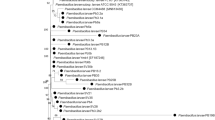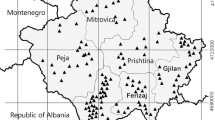Abstract
German and imported honeys from non-European countries were analysed for the presence of veterinary drugs and of Paenibacillus larvae spores that might pose a potential threat transmitting AFB into local beehives. The coherence of application levels of antibiotics and the incidence of P. larvae spores were investigated. P. larvae strains from imported honeys and strains isolated from local beehives were characterized by genetically subtyping to investigate a potential correlation of AFB-positive honeys and AFB cases in Hamburg. Whereas almost 50 % of the investigated non-EU honey samples contained at least 1 antibiotic residue, we detected antibiotic residues in only one out of 30 German honeys. As occurring antibiotic residues do not correlate with the presence of AFB spores the use of antibiotics in honey production remains obscure. We showed that the majority of AFB-positive samples from Hamburg and surrounding areas did not derive from imported AFB-positive honeys as the prevalent genotype in Hamburg is clearly distinct.
Similar content being viewed by others
References
Friedrich-Loeffler-Institute, Federal Research Institute for Animal Health, Tierseuchen-Nachrichtensystem. http://www.fli.de. Accessed 9 Oct 2015
Genersch E (2010) American Foulbrood in Honeybees and its causative agent, Paenibacillus larvae. J Invertebr Pathol 103:510–519
Genersch E, Otten C (2003) The use of repetitive element PCR fingerprinting (rep-PCR) for genetic subtyping of German field isolates of Paenibacillus larvae subsp. larvae. Apidologie 34:195–206
Institut für Hygiene und Umwelt (2011) Jahresbericht (http://www.hamburg.de/bgv/jahresberichte-hu/)
Lindström A, Korpela S, Fries I (2008) The distribution of Paenibacillus larvae spores in adult bees and honey and larval mortality, following the addition of American foulbrood diseased brood or spore-contaminated honey in honey bee (Apis mellifera) colonies. J Invertebr Pathol 99:82–86
Loncaric I, Derakhshifar I, Oberlechner JT, Köglberger H, Mossbeckhofer R (2009) Genetic diversity among isolates of Paenibacillus larvae from Austria. J Invertebr Pathol 100:44–46
Näumann G, Mahrt E, Himmelreich A, Mohring A, Frerichs H (2012) Traces of contamination: well preserved in honey. Investigation of veterinary drugs and American foulbrood in honeys of global origin. J Verbr Lebensm 7:35–43
Peters M, Kilwinski J, Beringhoff A, Reckling D, Genersch E (2006) American foulbrood of the honey bee: occurrence and distribution of different genotypes of Paenibacillus larvae in the administrative district of Arnsberg (North Rhine-Westphalia). J Vet Med B 53:100–104
Ritter W (2003) Early detection of American foulbrood by honey and wax analysis. APIACTA 38:125–130
Ulakova V, Kiss E, Kusinova J, Silhar S (2008) Kinetics of degradation of oxytetracycline and tetracycline in honey. J Food Nutr Res 47(3):139
Author information
Authors and Affiliations
Corresponding author
Additional information
The “Food Science Dialog” took place from September 15th to 18th 2015 in Hamburg, Germany and was hosted and organized by the Hamburg University of Applied Science (HAW), the Authority of Health and Consumer Protection (BGV) and the Authority for Science and Research (BWF) in Cooperation with the University of Wageningen, Netherlands.
Rights and permissions
About this article
Cite this article
Frerichs, H., Himmelreich, A. & Näumann, G. Traces of contamination–well preserved in honey. J. Verbr. Lebensm. 10 (Suppl 1), 39–43 (2015). https://doi.org/10.1007/s00003-015-0995-z
Published:
Issue Date:
DOI: https://doi.org/10.1007/s00003-015-0995-z




